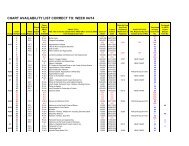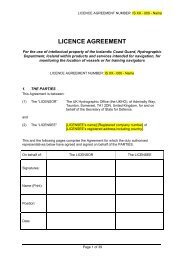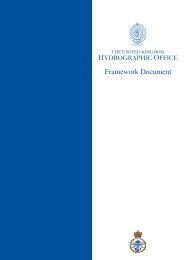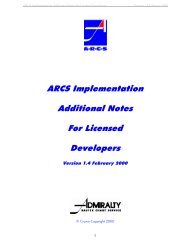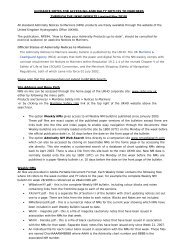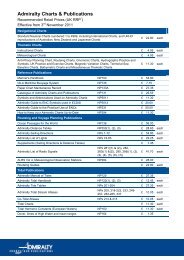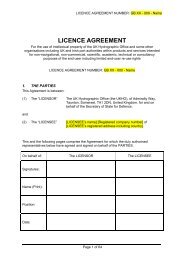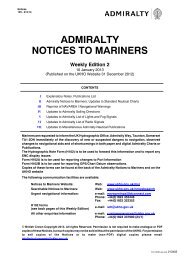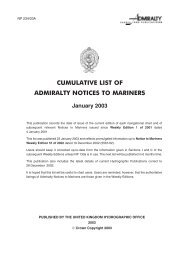Admiralty Notices to Mariners - United Kingdom Hydrographic Office
Admiralty Notices to Mariners - United Kingdom Hydrographic Office
Admiralty Notices to Mariners - United Kingdom Hydrographic Office
Create successful ePaper yourself
Turn your PDF publications into a flip-book with our unique Google optimized e-Paper software.
NOTES:<br />
HYDROGRAPHIC NOTE<br />
FOR GPS OBSERVATIONS AGAINST CORRESPONDING ADMIRALTY CHART<br />
POSITIONS<br />
(To accompany Form H.102)<br />
H.102B<br />
(V6.0 Dec 2012)<br />
1. This form is designed <strong>to</strong> assist in the reporting of observed differences between WGS 84 (GPS) Datum and British <strong>Admiralty</strong> Chart<br />
Datum by mariners, including yachtsmen, and should be submitted as an accompaniment <strong>to</strong> Form H.102 (full instructions for the<br />
rendering of data are on Form H.102). Where there is insufficient space on the form an additional sheet should be used.<br />
Objective of GPS Data Collection<br />
The UK <strong>Hydrographic</strong> <strong>Office</strong> would appreciate the reporting of GPS positions, referenced <strong>to</strong> WGS 84 Datum, at identifiable locations on<br />
<strong>Admiralty</strong> Charts. Such observations could be used <strong>to</strong> calculate positional shifts between WGS 84 and chart datums for those <strong>Admiralty</strong><br />
Charts which it has not yet been possible <strong>to</strong> compute the appropriate shifts. These would be incorporated in future new editions or new<br />
charts and promulgated by Preliminary <strong>Notices</strong> <strong>to</strong> <strong>Mariners</strong> in the interim.<br />
It is unrealistic <strong>to</strong> expect that a series of reported WGS 84 positions relating <strong>to</strong> a given chart will enable it <strong>to</strong> be referenced <strong>to</strong> that datum<br />
with the accuracy required for geodetic purposes. Nevertheless, this provides adequate accuracy for general navigation, considering the<br />
practical limits <strong>to</strong> the precision of 0.2mm (probably the best possible under ideal conditions – vessel alongside, good light, sharp dividers<br />
etc), this represents 10 metres on the ground at a chart scale of 1:50.000.<br />
It is clear that users prefer <strong>to</strong> have some indication of the magnitude and direction of the positional shift, <strong>to</strong>gether with an assessment of<br />
its likely accuracy, rather than be informed that a definitive answer cannot be formulated. Consequently, where a WGS 84 version has not<br />
yet been produced, many charts now carry approximate shifts relating WGS 84 Datum <strong>to</strong> chart datum. Further observations may enable<br />
these values <strong>to</strong> be refined with greater confidence.<br />
2. Details required<br />
a. It is essential that the chart number, edition date and its correctional state (latest NM) are stated. For ENCs, please state the ENC<br />
name and latest update applied.<br />
b. Position (<strong>to</strong> 2 decimal places of a minute) of observation point, using chart graticule or, if ungraduated, relative position by<br />
bearing/distance from prominent charted features (navigation lights, trig. points, church spires etc.).<br />
c. Position (<strong>to</strong> 2 decimal places of a minute) of observation point, using GPS Receiver. Confirm that GPS positions are referenced <strong>to</strong><br />
WGS 84 Datum.<br />
d. Include GPS receiver model and aerial type (if known). Also of interest: values of PDOP, HDOP or GDOP displayed (indications of<br />
theoretical quality of position fixing depending upon the distribution of satellites overhead) and any other comments.



